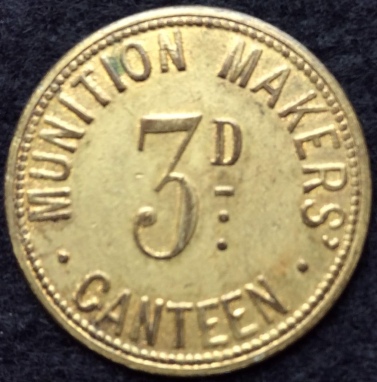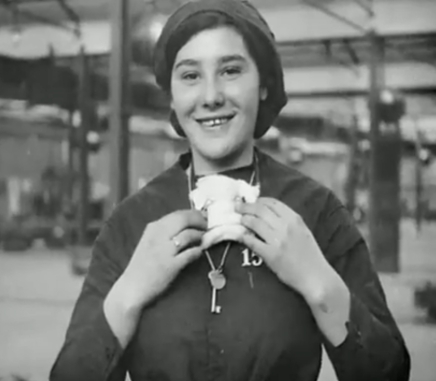This website aims to act as a hub for disseminating information and research related to the subject of tokens, checks and passes (i.e. paranumismatics) associated with ordnance and munitions manufacture as well as military supply industry activities (i.e. War Work) in the British Isles. The site’s principal period of focus is the Great War (1914 to 1918) although related tokens prior to this period as well as from the Second World War (1939 to 1945) plus inter and post war years are also included.

An anonymously issued 3d brass canteen token issued for use by workers employed in a British munitions factory canteen during the Great War of 1914-18.
A longer term aim of this site will be to list, and wherever possible, illustrate all known types of paranumistmatics related to the above stated subject matter. The bulk of the tokens discussed were used by civilian workers employed in the manufacture of armaments (including airplanes and ships), weapons, explosives, munitions, military equipment and uniforms etc. at either privately owned or, more often, British Government operated specialist factories. These were located throughout the length and breadth of the United Kingdom. Some of these specialist manufacturing centres, both Government and privately operated, existed prior to the outbreak of the Great War in 1914. However, many of them were created during, or shortly after, 1915 by the British Government’s Ministry of Munitions under the “National Factory & Shipyard Schemes“. The new manufacturing facilities created under these epic schemes were operated by the British Government often using local management teams drawn from or representing one or more related private company who were already established in such lines of work. The National Factories were often purpose-built on new sites or, in some cases, utilised existing industrial facilities which were adapted for their new uses. While several of these new “National Factories” were decommissioned after the Great War others continued to operate, on reduced production targets. Many of these latter facilities were again brought into full production during the Second World War with several of them continuing to serve the nation’s needs thereafter.
The tokens, checks and passes used at the above establishments fulfilled a variety of purposes. Despite being only 100 or fewer years old often their precise and detailed method of use remains unknown with no records remaining which pertain to them. In such cases their designs including legends plus the appearance of a monetary value or in many cases of a counter stamped identification number, allow their original functions and methods of use to be hypothesized or assumed based on those of similar contemporary industrial tokens whose functions are known and documented. A typical listing of common token uses can be found elsewhere on this site.

A Great War “munitionette” wearing her changing room locker key and personal identification check (or works pass) around her neck for safe keeping
In the majority of cases the tokens in question were manufactured from die struck metal discs of various size and shape (typically circular, rectangular, hexagonal, octagonal or square). Most frequently the tokens were made of brass or a from white metal (often zinc based) alloy. Others are known to have been struck on aluminium or made of stamped or injection moulded coloured plastics . Some are possibly made of bone. Their designs were both bi-facial (i.e. bearing designs on both sides) and uniface (i.e. bearing a design on only one side) in appearance.